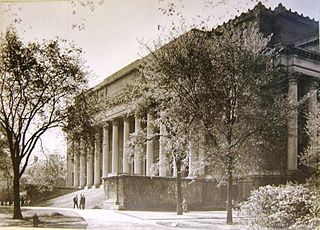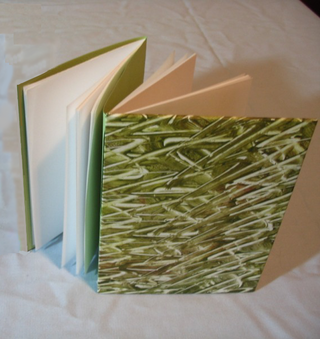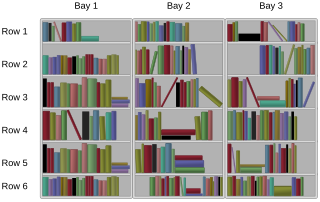Related Research Articles

A library classification is a system used within a library to organize materials, including books, sound and video recordings, electronic materials, etc., both on shelves and in catalogs and indexes. Each item is typically assigned a call number, which identifies the location of the item within the system. Materials can be arrange by many different factors, typically in either a hierarchical tree structure based on the subject or using a faceted classification system, which allows the assignment of multiple classifications to an object, enabling the classifications to be ordered in many ways.

An aisle is a linear space for walking with rows of non-walking spaces on both sides. Aisles with seating on both sides can be seen in airplanes, in buildings such as churches, cathedrals, synagogues, meeting halls, parliaments, courtrooms, theatres, and in long passenger vehicles. An aisle floor may be level or, as in theatres, sloping upward from a stage.

Optical disc packaging is the packaging that accompanies CDs, DVDs, and other formats of optical discs. Most packaging is rigid or semi-rigid and designed to protect the media from scratches and other types of exposure damage.

The Harry Elkins Widener Memorial Library, housing some 3.5 million books in its "vast and cavernous" stacks, is the centerpiece of the Harvard College Libraries and, more broadly, of the entire Harvard Library system. It honors 1907 Harvard College graduate and book collector Harry Elkins Widener, and was built by his mother Eleanor Elkins Widener after his death in the sinking of the RMS Titanic in 1912.

A bookcase, or bookshelf, is a piece of furniture with horizontal shelves, often in a cabinet, used to store books or other printed materials. Bookcases are used in private homes, public and university libraries, offices, schools, and bookstores. Bookcases range from small, low models the height of a table to high models reaching up to ceiling height. Shelves may be fixed or adjustable to different positions in the case. In rooms entirely devoted to the storage of books, such as libraries, they may be permanently fixed to the walls and/or floor.
The National Library for the Blind (NLB) was a public library in the United Kingdom, founded 1882, which aimed to ensure that people with sight problems have the same access to library services as sighted people. NLB was taken over by the Royal National Institute of Blind People on 1 January 2007 and incorporated into the RNIB National Library Service.

A chained library is a library where the books are attached to their bookcase by a chain, which is sufficiently long enough to allow the books to be taken from their shelves and read, but not removed from the library itself. The practice was usual for reference libraries from the Middle Ages to around the 18th century. This would prevent theft of the library's materials. Since the chaining process was also expensive, it was not used on all books, only the more valuable books such as reference works or large books in a collection were chained. Librarians in the Middle Ages often invoked curses as well to keep books from being stolen. Once such curse written into the books was,

Book design is the art of incorporating the content, style, format, design, and sequence of the various components and elements of a book into a coherent unit. In the words of renowned typographer Jan Tschichold (1902–1974), book design, "though largely forgotten today, [relies upon] methods and rules upon which it is impossible to improve, [and which] have been developed over centuries. To produce perfect books, these rules have to be brought back to life and applied". Richard Hendel describes book design as "an arcane subject", and refers to the need for a context to understand what that means.

In bookbinding, a dos-à-dos binding is a binding structure in which two separate books are bound together such that the fore edge of one is adjacent to the spine of the other, with a shared lower board between them serving as the back cover of both. When shelved, the spine of the book to the right faces outward, while the spine of the book to the left faces the back of the shelf; the text of both works runs head-to-tail.

Book scanning or book digitization is the process of converting physical books and magazines into digital media such as images, electronic text, or electronic books (e-books) by using an image scanner. Large scale book scanning projects have made many books available online.
Foredge shelving is a book shelving technique. Books are typically shelved upright with the spines facing outwards. However, when a book is too tall to stand upright on a shelf it may be shelved horizontally, i.e., flat, or with the spine resting on the shelf, or alternatively with the foredge, i.e., the part of the book opposite the spine, resting on the shelf.

Bookbinding is the process of building a book, usually in codex format, from an ordered stack of paper sheets with one's hands and tools, or in modern publishing, by a series of automated processes. Firstly, one binds the sheets of papers along an edge with a thick needle and strong thread. One can also use loose-leaf rings, binding posts, twin-loop spine coils, plastic spiral coils, and plastic spine combs, but they last for a shorter time. Next, one encloses the bound stack of paper in a cover. Finally, one places an attractive cover onto the boards, and features the publisher's information and artistic decorations.
In the context of libraries and archives, an inventory refers to a detailed list or record of the items, materials, or resources held within a collection.

A shelf is a flat, horizontal plane used for items that are displayed or stored in a home, business, store, or elsewhere. It is raised off the floor and often anchored to a wall, supported on its shorter length sides by brackets, or otherwise anchored to cabinetry by brackets, dowels, screws, or nails. It can also be held up by columns or pillars. A shelf is also known as a counter, ledge, mantel, or rack. Tables designed to be placed against a wall, possibly mounted, are known as console tables, and are similar to individual shelves.

An adjustable shelf is a shelf that can be adjusted according to needs. The most common variant is that the height intervals can be adjusted to accommodate various items. This allows more flexible use to hold items of value for storage, display or sale. Like fixed shelves, the horizontal planes are normally made of strong materials such as wood or steel, but their exact vertical positioning can be varied - usually through the use of uprights into which supporting brackets or the shelves themselves can be fixed at different heights.

A cabinet is a case or cupboard with shelves or drawers for storing or displaying items. Some cabinets are stand alone while others are built in to a wall or are attached to it like a medicine cabinet. Cabinets are typically made of wood, coated steel, or synthetic materials. Commercial grade cabinets usually have a melamine-particleboard substrate and are covered in a high-pressure decorative laminate, commonly referred to as Wilsonart or Formica.

The conservation and restoration of books, manuscripts, documents, and ephemera is an activity dedicated to extending the life of items of historical and personal value made primarily from paper, parchment, and leather. When applied to cultural heritage, conservation activities are generally undertaken by a conservator. The primary goal of conservation is to extend the lifespan of the object as well as maintaining its integrity by keeping all additions reversible. Conservation of books and paper involves techniques of bookbinding, restoration, paper chemistry, and other material technologies including preservation and archival techniques.

In library science and architecture, a stack or bookstack is a book storage area, as opposed to a reading area. More specifically, this term refers to a narrow-aisled, multilevel system of iron or steel shelving that evolved in the 19th century to meet increasing demands for storage space. An "open-stack" library allows its patrons to enter the stacks to browse for themselves; "closed stacks" means library staff retrieve books for patrons on request.

A bay is a basic unit of library shelving. Bays are bookcases about 3 feet (0.9 m) wide, arranged together in rows.

The Town Library of Ipswich is a collection of 871 titles organised in 944 volumes published between 1474 and 1760. In addition there are 10 manuscripts. This collection was made by the Ipswich Corporation to provide resources for the Ipswich Town Preacher. It is now located in the headmaster's study at Ipswich School, where they are cared for on behalf of the town. As distinct from the St James Library which had more limited access in nearby Bury St Edmunds, it was open to all freemen of the Ipswich Corporation.
References
- ↑ ISO. ISO 6357:1985(en) Documentation — Spine titles on books and other publications. https://www.iso.org/obp/ui/#iso:std:iso:6357:ed-1:v1:en
- 1 2 3 4 5 6 7 Weihs, J. (2009, Mar/Apr). A brief history of shelving. Technicalities(29):2, p.11.
- 1 2 Petroski, H. (2000). The book on the bookshelf. New York: Vintage Books.
- 1 2 3 4 Sylverne, S. (2015, July 30). When books were shelved backwards. Medium https://medium.com/@kvetchingyenta/when-books-were-shelved-backwards-b6a15fe82a3
- 1 2 Francesca, M. (2012, December 27). Shelf-conscious. The Paris Review https://www.theparisreview.org/blog/2012/12/27/shelf-conscious/
- 1 2 Patton, M. (2021). Spine tingling: Looking closely at the spine could unlock the mystery of a rare book, or it could raise more questions. State Library, New South Wales. https://www.sl.nsw.gov.au/stories/spine-tingling